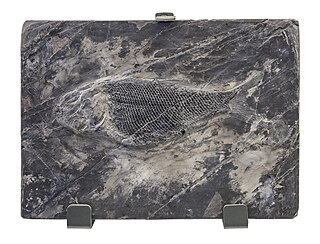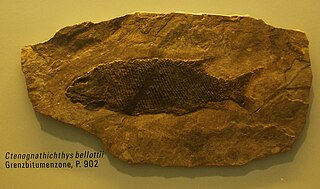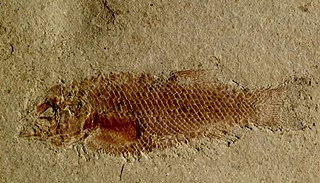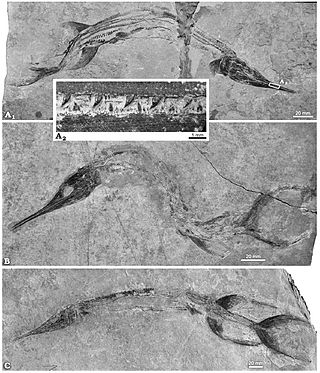
Saurichthys is an extinct genus of predatory ray-finned fish from the Triassic Period. It is the type genus of the family Saurichthyidae, and the most speciose and longest lasting genus in the family. This family also includes the Permian Eosaurichthys (China) and the Jurassic Saurorhynchus from Europe and North America, though it may be more appropriate to treat these as subgenera of Saurichthys, due to the genus Saurichthys otherwise being paraphyletic.

Perleidus is an extinct genus of ray-finned fish from the Triassic period. Fossils have been found in the Middle Triassic of Italy, Switzerland, and China. The inclusion of Early Triassic species in the genus Perleidus was questioned.

Birgeria is a genus of carnivorous marine ray-finned fish from the Triassic period. Birgeria had a global distribution, with fossil known from Madagascar, Spitsbergen, Germany, Switzerland, Italy, Slovenia, China, Russia, Canada and Nevada, United States. The oldest fossils are from Griesbachian aged beds of the Wordie Creek Formation of East Greenland. Birgeria existed throughout the entire Triassic period, from the very beginning just after the Permian-Triassic mass extinction, up to the very end with its extinction during the Triassic-Jurassic mass extinction.

Thoracopterus is an extinct genus of overwater gliding ray-finned fish. It was common to the late Middle Triassic and Late Triassic epochs in what is now Europe and China.

Archaeolepidotus is an extinct genus of prehistoric marine holostean bony fish that lived during the latest Permian or earliest Triassic in what is now Trentino-Alto Adige, Italy. It contains a single species, A. leonardii. It is among the earliest known fossil neopterygians, and is usually recovered as a semionotiform, but others recover it as a parasemionotiform.

Asialepidotus is an extinct genus of prehistoric marine ray-finned fish that lived during the Ladinian stage of the Middle Triassic epoch. It contains a single species, A. shingyiensis, from Guizhou, China.
Eosaurichthys is an extinct genus of saurichthyid ray-finned fish that lived during the late Permian epoch in what is now China.
Gigantopterus is an extinct genus of prehistoric bony fish that lived during the Carnian stage of the Late Triassic epoch.
Crenilepis is an extinct genus of prehistoric bony fish that lived in the seas of present-day Europe during the Anisian stage of the Middle Triassic epoch.

Ctenognathichthys is an extinct genus of prehistoric bony fish that lived during the Anisian and Ladinian ages of the Middle Triassic epoch in what is now southern/southeastern Switzerland and northern Italy.

Acentrophorus is an extinct genus of prehistoric freshwater and marine ray-finned fish from the Roadian to the Wuchiapingian of England, Germany (Kupferschiefer), Italy and Russia. There may also be a Triassic occurrence in Australia.

Allolepidotus is an extinct genus of prehistoric marine neopterygian ray-finned fish from the Middle Triassic epoch of what is now Italy, Spain, and Switzerland. It was formerly referred to the halecomorph order Panxianichthyiformes, but is now thought to be a member of the Ionoscopiformes.

Bobasatrania is an extinct genus of prehistoric marine ray-finned fish that survived the Permian-Triassic extinction event. Fossils of Bobasatrania were found in beds of Changhsingian to Ladinian age. It was most speciose during the Early Triassic.

Dipteronotus is an extinct genus of stem-neopterygian ray-finned fish that existed during the Middle and Late Triassic epochs in what is now Europe and Morocco. As a typical feature, it had several ridge scales in front of its dorsal fin that created a spine-like structure.

Dandya is an extinct genus of ray-finned fish belonging to the family Dapediidae. It contains one species, D. ovalis. It is known from the Late Triassic of Lombardy, Northern Italy.

Prohalecites is an extinct genus of ray-finned fish from the Ladinian and possibly Carnian (Triassic) of Italy. It is the oldest known teleosteomorph, a group that includes extant teleosts and their close fossil relatives.

Pholidorhynchodon is an extinct genus of ray-finned fish that lived in the Triassic. Its fossils have been found in Italy, in the Zorzino Limestone Formation in Cene.

Sinosaurichthys is an extinct genus of saurichthyid ray-finned fish, which existed in southwestern China during the Middle Triassic. Fossils have been found in the Upper Member of the Guanling Formation of two localities: Yangjuan of Panxian County, Guizhou Province, and Dawazi of Luoping, Yunnan Province, China.

Saurichthyiformes is an extinct order of ray-finned fish which existed in Asia, Africa, Australia, Europe and North America, during the late Permian to early Middle Jurassic. Saurichthyiiformes comprise two families, Saurichthyidae and Yelangichthyidae. Yelangichthyidae is monotypic, containing only the genus Yelangichthys. The gar or needlefish-like Saurichthyidae is primarily known from the genus Saurichthys. Additionally, the subgenera SaurorhynchusCostasaurichthys, Eosaurichthys, Lepidosaurichthys, and Sinosaurichthys are frequently used to group species, and are sometimes considered separate genera. Species are known from both marine end freshwater deposits. They had their highest diversity during the Early and Middle Triassic. Their phylogenetic position is uncertain, while they have often been considered members of Chondrostei, and thus related to living sturgeons and paddlefish, phylogenetic analysis of well-preserved remains has considered this relationship equivocal. They may actually belong to the stem-group of Actinopterygii, and thus not closely related to any living group of ray-finned fish.

Thoracopteridae is an extinct family of prehistoric bony fish; classified with the order Peltopleuriformes. This lineage of Triassic flying fish-like Perleidiformes converted their pectoral and pelvic fins into broad wings very similar to those of their modern counterparts. However, this group is not related to modern flying fish from the family Exocoetidae, instead being a case of convergent evolution.


















